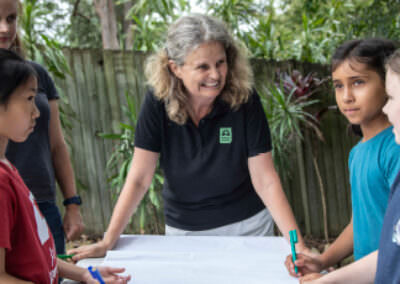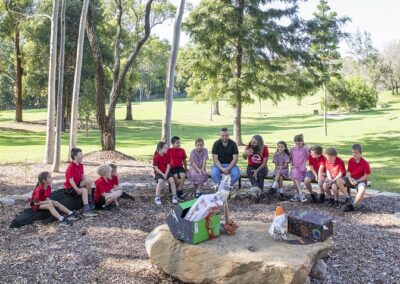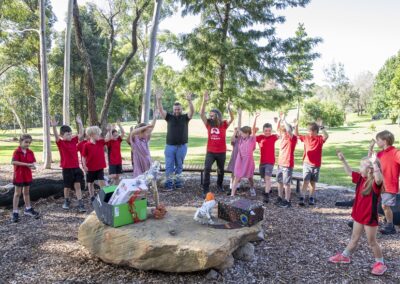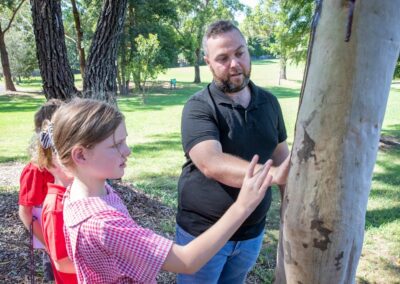LEARNING ACTIVITY
STORY
Suddenly, the idea came to Mrs Smith: “I know, the yarning circle!” Earlier that week, Mrs Smith had been wondering how to better create a balanced, settled start to the school day.
She had been noticing that recently, some students needed time to settle in the morning and was wondering how to check-in with everyone and establish a positive beginning to the day. That day, during planning time, she looked up some ideas for morning circles. To her amazement, she discovered a great many crossovers between morning circles and the objectives of a yarning circle.
The next day, as soon as the bell rang, Mrs Smith and the class went to the yarning circle for their morning circle. Even just the short time they spent together to check-in, have a chat about how everyone was feeling and identify things that everyone would focus on for the day, helped to make the class feel more connected and ready to start the day.

This activity is the final activity in an 8-part activity sequence that has been developed to help you design, build and use a yarning circle in your space.
This activity will help you make connections between yarning and wellbeing programs, and how you can use yarning circles to support respectful, honest and open communication to promote connectedness among students.
The order of these learning activities are: background, site selection, involving First Nations people, building the yarning circle, connecting to Landcare, using the yarning circle, yarning circle activities and yarning and wellbeing.
For children to:
- use the yarning circle as part of their wellbeing programs
- feel confident and comfortable talking about their feelings
- understand that communication can help improve the way they feel.
This activity can be undertaken at any time of the year.
Introduction
In this learning activity we explore how yarning circles can be used for wellbeing based on the morning circle routine. However, there are many other ways you can use your yarning circle for wellbeing activities, for example, for dispute resolution, restorative practice and cultural sharing.
Being outdoors tends to allow us to slow down and reflect. A well set-up yarning circle can provide a welcoming atmosphere and can be utilised as a safe space to talk, share, discuss and have a yarn together; a place to build respectful relationships and enrich not just students' learning experiences but their overall sense of wellbeing in a natural setting.
It's also a great place to invite First Nations community members to share more about their Culture and run cultural activities like weaving, stories, Indigenous plant use and bushfood tasting, even cooking if the amenities are available; the meditative practice of weaving, art and cooking can also have positive effects on mental health.
Finally, providing First Nations students with an opportunity to showcase their Culture is an important way to create a better understanding of self and identity, which is a powerful tool in improving wellbeing; whilst exposing non-Indigenous children to Aboriginal and Torres Strait Islander Cultures is an important way to develop respect for diversity and Traditional Cultural Knowledge.
Checklist
Instructions

Step 1
Before you start:
Research morning circles, what they are used for and how they can be conducted. It could also be useful for you or members of your team to undertake professional development, such as the Berry Street Educational Model to give you more confidence in running this type of activity.
Morning circles are part of the daily routine and provide a consistent, predictable way to start the day and emphasise connectedness and belonging.

Step 2
Start your morning circle:
The morning circle can be led by the teacher or students as they learn how to run the circle.
Begin this activity with an Acknowledgement of Country. By acknowledging the Land, you are also making a promise that you will recognise the cultural practices of First Nations people.

Step 3
Create a positive start:
Start with a greeting that moves around the circle. This may include a fist-bump, gesture or similar. Include an Indigenous word from your area that is used as a greeting. (Use the research from the extension activity in Creating a yarning circle: Connecting with First Nations people for more information.)
Check in. This can be a response to a question such as, ‘How are we feeling?’ or ‘Are we ready to learn?’ Students can respond with a gesture or verbally. (This provides the teacher with an indication of where everyone is at and if further follow-up is required.)
Describe a value/trait/skill that you would like to focus on and how you would like to achieve this. Ask other participants in the circle to describe their own value/trait/skill that they would like to focus on today.

Step 4
Set up the day:
As a group, discuss the expectations for the day. Get feedback from the group about how the expectations can be met.
Make any announcements that will affect how the day will run and allow students to share important news/events such as birthdays.
Finish your morning circle with an activity such as a positive primer or brain break activity. This activity should be short, engaging and include the whole group. It could be:
- a short game
- investigating or observing a plant or animal in your yarning circle space
- brain teasers or puzzles.
Extension Activity
Use the yarning circle for Restorative Practice conversations, peer mediation and other conversations should they need to occur.
Curriculum and Framework Links
SCIENCE
Year 5: ACSHE083
Year 7: ACSHE120
Year 8: ACSHE135
HUMANITIES AND SOCIAL SCIENCES
Year 2: ACHASSI042
Year 3: ACHASSI052, ACHASSI059, ACHASSI060
Year 4: ACHASSI080, ACHASSK088, ACHASSK090
Year 5: ACHASSI102, ACHASSK120
Year 6: ACHASSI122, ACHASSI130
DESIGN AND TECHNOLOGIES
Year 2: ACTDEK003
Year 3 & 4: ACTDEP017
Year 5 & 6: ACTDEP019
Year 7 & 8: ACTDEK032
HEALTH AND PHYSICAL EDUCATION
Year 2: ACPPS018, ACPPS022, ACPPS023
Year 3 & 4: ACPPS036, ACPPS040, ACPPS041
Year 5 & 6: ACPPS054, ACPPS059
Year 7 & 8: ACPPS073, ACPPS078
ABORIGINAL AND TORRES STRAIT ISLANDER HISTORIES AND CULTURES
ETHICAL UNDERSTANDING
Exploring values, rights and responsibilities.
PERSONAL AND SOCIAL CAPABILITY
CURRICULUM CONNECTIONS
CROSS CURRICULUM PRIORITY
MY TIME, OUR PLACE: FRAMEWORK FOR SCHOOL AGE CARE
Reference List
ONLINE RESOURCES
Explore the eSafety Commissioner’s Yarning Circle lesson plan.
PRINTABLE RESOURCES
Try these Circle Time Warm-up Activity Ideas for children of all ages.
WATCH
Student Wellbeing Hub’s (Commonwealth Government) Using Circle Time for Restorative Practice video.
Watch First Nations student Zara explain what it means to her to be able to share more about her First Nations Culture with her friends, here.
READ
The Queensland Curriculum and Assessment Authority’s Yarning Circle overview and tips for bringing yarning circles into the classroom.
NETWORK
We recommend reaching out to the Local Traditional owners and First Nations peoples community groups who can assist in knowledge sharing and understanding local land, language, stories and culture.
To reach out or find contacts in your local First Nations community you could speak to parents of First Nations students, to an Indigenous Learning Officer (ILO) at your school or to a local Land council.
We have some suggested organisations to approach listed on our Junior Landcare Community page.
We value your feedback
When you have finished this learning activity, please tell us what you think with our survey.
Your feedback will help Landcare Australia improve the activities in the Junior Landcare Learning Centre.
Why not try one of our other Junior Landcare learning activities?
Creating an Indigenous plant-use garden: plant list
First Nations Perspectives
Creating an Indigenous plant-use garden: resources from the bush
First Nations Perspectives
Love Letters to the Land
Biodiversity|First Nations Perspectives|Food Production|Waste Management
Creating a yarning circle: involving First Nations people
First Nations Perspectives